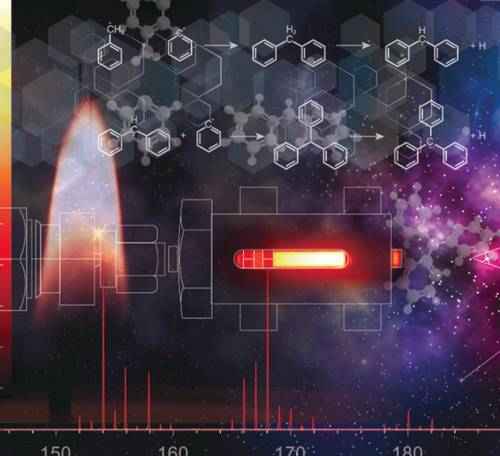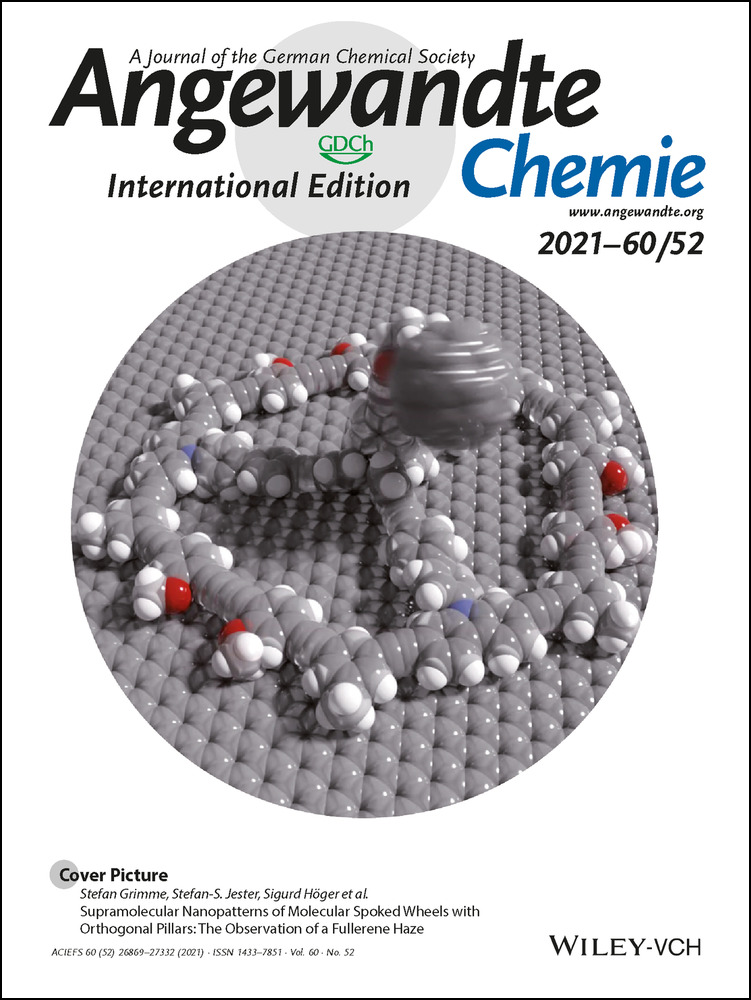Experimental Observation of Hydrocarbon Growth by Resonance-Stabilized Radical–Radical Chain Reaction
David E. Couch
Gas Phase Chemical Physics Department, Combustion Research Facility, Sandia National Laboratories, Livermore, CA, 94550 USA
Search for more papers by this authorAngie J. Zhang
Gas Phase Chemical Physics Department, Combustion Research Facility, Sandia National Laboratories, Livermore, CA, 94550 USA
Search for more papers by this authorCraig A. Taatjes
Gas Phase Chemical Physics Department, Combustion Research Facility, Sandia National Laboratories, Livermore, CA, 94550 USA
Search for more papers by this authorCorresponding Author
Nils Hansen
Gas Phase Chemical Physics Department, Combustion Research Facility, Sandia National Laboratories, Livermore, CA, 94550 USA
Search for more papers by this authorDavid E. Couch
Gas Phase Chemical Physics Department, Combustion Research Facility, Sandia National Laboratories, Livermore, CA, 94550 USA
Search for more papers by this authorAngie J. Zhang
Gas Phase Chemical Physics Department, Combustion Research Facility, Sandia National Laboratories, Livermore, CA, 94550 USA
Search for more papers by this authorCraig A. Taatjes
Gas Phase Chemical Physics Department, Combustion Research Facility, Sandia National Laboratories, Livermore, CA, 94550 USA
Search for more papers by this authorCorresponding Author
Nils Hansen
Gas Phase Chemical Physics Department, Combustion Research Facility, Sandia National Laboratories, Livermore, CA, 94550 USA
Search for more papers by this authorGraphical Abstract
Radical–radical chain reactions may contribute to rapid growth of polycyclic aromatic hydrocarbons in combustion and astrochemical environments. Phenyl and benzyl radicals were experimentally observed to complete this chain reaction, producing diphenylmethyl and triphenylmethyl radicals by prompt H-atom loss (see scheme). This observation confirms the plausibility of such chain reactions at high temperature and low pressure.
Abstract
Rapid molecular-weight growth of hydrocarbons occurs in flames, in industrial synthesis, and potentially in cold astrochemical environments. A variety of high- and low-temperature chemical mechanisms have been proposed and confirmed, but more facile pathways may be needed to explain observations. We provide laboratory confirmation in a controlled pyrolysis environment of a recently proposed mechanism, radical–radical chain reactions of resonance-stabilized species. The recombination reaction of phenyl (c-C6H5) and benzyl (c-C6H5CH2) radicals produces both diphenylmethane and diphenylmethyl radicals, the concentration of the latter increasing with rising temperature. A second phenyl addition to the product radical forms both triphenylmethane and triphenylmethyl radicals, confirming the propagation of radical–radical chain reactions under the experimental conditions of high temperature (1100–1600 K) and low pressure (ca. 3 kPa). Similar chain reactions may contribute to particle growth in flames, the interstellar medium, and industrial reactors.
Supporting Information
As a service to our authors and readers, this journal provides supporting information supplied by the authors. Such materials are peer reviewed and may be re-organized for online delivery, but are not copy-edited or typeset. Technical support issues arising from supporting information (other than missing files) should be addressed to the authors.
| Filename | Description |
|---|---|
| anie202110929-sup-0001-misc_information.pdf395.6 KB | Supporting Information |
Please note: The publisher is not responsible for the content or functionality of any supporting information supplied by the authors. Any queries (other than missing content) should be directed to the corresponding author for the article.
References
- 1
- 1aU.S. EPA. Integrated Science Assessment (ISA) for Particulate Matter (Final Report, Dec 2019), U. S. Environmental Protection Agency, Washington, DC, EPA/600/R-19/188, 2019;
- 1bH. Wang, Proc. Combust. Inst. 2011, 33, 41–67;
- 1cJ. S. Lighty, J. M. Veranth, A. F. Sarofim, J. Air Waste Manage. Assoc. 2000, 50, 1565–1618.
- 2
- 2aJ. J. Deng, Y. You, V. Sahajwalla, R. K. Joshi, Carbon 2016, 96, 105–115;
- 2bM. U. Zahid, E. Pervaiz, A. Hussain, M. I. Shahzad, M. B. K. Niazi, Mater. Res. Express 2018, 5, 052002;
- 2cH. Zhang, H. Zhou, Y. Wang, S. Li, P. Biswas, Energy Fuels 2021, 35, 63–85;
- 2dS. Pokhrel, L. Mädler, Energy Fuels 2020, 34, 13209–13224.
- 3D. E. Rosner, Ind. Eng. Chem. Res. 2005, 44, 6045–6055.
- 4A. G. G. M. Tielens, Rev. Mod. Phys. 2013, 85, 1021–1081.
- 5R. I. Kaiser, N. Hansen, J. Phys. Chem. A 2021, 125, 3826–3840.
- 6
- 6aM. Frenklach, D. W. Clary, W. C. Gardiner, S. E. Stein, Symp. Combust. [Proc.] 1985, 20, 887–901;
10.1016/S0082-0784(85)80578-6 Google Scholar
- 6bM. Frenklach, W. C. Gardiner, S. E. Stein, D. W. Clary, T. Yuan, Combust. Sci. Technol. 1986, 50, 79–115;
- 6cM. Frenklach, H. Wang, Symp. Combust. [Proc.] 1991, 23, 1559–1566;
10.1016/S0082-0784(06)80426-1 Google Scholar
- 6dD. S. N. Parker, R. I. Kaiser, T. P. Troy, M. Ahmed, Angew. Chem. Int. Ed. 2014, 53, 7740–7744; Angew. Chem. 2014, 126, 7874–7878;
- 6eT. Yang, T. P. Troy, B. Xu, O. Kostko, M. Ahmed, A. M. Mebel, R. I. Kaiser, Angew. Chem. Int. Ed. 2016, 55, 14983–14987; Angew. Chem. 2016, 128, 15207–15211.
- 7R. I. Kaiser, D. S. N. Parker, A. M. Mebel, Annu. Rev. Phys. Chem. 2015, 66, 43–67.
- 8
- 8aB. Shukla, A. Susa, A. Miyoshi, M. Koshi, J. Phys. Chem. A 2008, 112, 2362–2369;
- 8bS. Xiong, J. Li, J. Wang, Z. Li, X. Li, Comput. Theor. Chem. 2012, 985, 1–7;
- 8cL. Zhao, M. B. Prendergast, R. I. Kaiser, B. Xu, U. Ablikim, M. Ahmed, B. J. Sun, Y. L. Chen, A. H. H. Chang, R. K. Mohamed, F. R. Fischer, Angew. Chem. Int. Ed. 2019, 58, 17442–17450; Angew. Chem. 2019, 131, 17603–17611.
- 9N. Hansen, M. Schenk, K. Moshammer, K. Kohse-Höinghaus, Combust. Flame 2017, 180, 250–261.
- 10
- 10aA. M. Mebel, A. Landera, R. I. Kaiser, J. Phys. Chem. A 2017, 121, 901–926;
- 10bD. S. N. Parker, F. T. Zhang, Y. S. Kim, R. I. Kaiser, A. Landera, V. V. Kislov, A. M. Mebel, A. Tielens, Proc. Natl. Acad. Sci. USA 2012, 109, 53–58;
- 10cA. M. Thomas, M. Lucas, T. Yang, R. I. Kaiser, L. Fuentes, D. Belisario-Lara, A. M. Mebel, ChemPhysChem 2017, 18, 1971–1976;
- 10dL. Zhao, R. I. Kaiser, B. Xu, U. Ablikim, M. Ahmed, M. M. Evseev, E. K. Bashkirov, V. N. Azyazov, A. M. Mebel, Angew. Chem. Int. Ed. 2020, 59, 4051–4058; Angew. Chem. 2020, 132, 4080–4087;
- 10eL. Zhao, R. I. Kaiser, B. Xu, U. Ablikim, M. Ahmed, M. V. Zagidullin, V. N. Azyazov, A. H. Howlader, S. F. Wnuk, A. M. Mebel, J. Phys. Chem. Lett. 2018, 9, 2620–2626;
- 10fL. Zhao, R. I. Kaiser, B. Xu, U. Ablikim, M. Ahmed, M. M. Evseev, E. K. Bashkirov, V. N. Azyazov, A. M. Mebel, Nat. Astron. 2018, 2, 973–979;
- 10gL. Zhao, B. Xu, U. Ablikim, W. C. Lu, M. Ahmed, M. M. Evseev, E. K. Bashkirov, V. N. Azyazov, A. H. Howlader, S. F. Wnuk, A. M. Mebel, R. I. Kaiser, ChemPhysChem 2019, 20, 791–797;
- 10hL. Zhao, R. I. Kaiser, B. Xu, U. Ablikim, W. C. Lu, M. Ahmed, M. M. Evseev, E. K. Bashkirov, V. N. Azyazov, M. V. Zagidullin, A. N. Morozov, A. H. Howlader, S. F. Wnuk, A. M. Mebel, D. Joshi, G. Veber, F. R. Fischer, Nat. Commun. 2019, 10, 1510;
- 10iL. Zhao, R. I. Kaiser, W. C. Lu, O. Kostko, M. Ahmed, M. M. Evseev, E. K. Bashkirov, A. D. Oleinikov, V. N. Azyazov, A. M. Mebel, A. H. Howlader, S. F. Wnuk, Phys. Chem. Chem. Phys. 2020, 22, 22493–22500;
- 10jL. Zhao, R. I. Kaiser, W. C. Lu, M. Ahmed, M. M. Evseev, E. K. Bashkirov, V. N. Azyazov, C. Tonshoff, F. Reicherter, H. F. Bettinger, A. M. Mebel, Angew. Chem. Int. Ed. 2020, 59, 11334–11338; Angew. Chem. 2020, 132, 11430–11434;
- 10kR. I. Kaiser, D. S. N. Parker, A. M. Mebel, Annu. Rev. Phys. Chem. 2015, 66, 43–67.
- 11S. Doddipatla, G. R. Galimova, H. Wei, A. M. Thomas, C. He, Z. Yang, A. N. Morozov, C. N. Shingledecker, A. M. Mebel, R. I. Kaiser, Sci. Adv. 2021, 7, eabd4044.
- 12K. O. Johansson, M. P. Head-Gordon, P. E. Schrader, K. R. Wilson, H. A. Michelsen, Science 2018, 361, 997–1000.
- 13I. Cherchneff, Astron. Astrophys. 2012, 545, A12.
- 14
- 14aA. N. Morozov, A. M. Mebel, J. Phys. Chem. A 2019, 123, 1720–1729;
- 14bA. N. Morozov, A. M. Mebel, Phys. Chem. Chem. Phys. 2020, 22, 6868–6880;
- 14cJ. A. Miller, S. J. Klippenstein, J. Phys. Chem. A 2003, 107, 7783–7799;
- 14dA. Matsugi, A. Miyoshi, Proc. Combust. Inst. 2013, 34, 269–277.
- 15M. Frenklach, A. M. Mebel, Phys. Chem. Chem. Phys. 2020, 22, 5314–5331.
- 16
- 16aH. F. Jin, J. J. Guo, T. Y. Li, Z. Y. Zhou, H. G. Im, A. Farooq, Fuel 2021, 289, 119931;
- 16bG. Kukkadapu, S. W. Wagnon, W. J. Pitz, N. Hansen, Proc. Combust. Inst. 2021, 38, 1477–1485.
- 17A. Menon, J. W. Martin, J. Akroyd, M. Kraft, J. Phys. Chem. A 2020, 124, 10040–10052.
- 18K. Gleason, F. Carbone, A. J. Sumner, B. D. Drollette, D. L. Plata, A. Gomez, Combust. Flame 2021, 223, 398–406.
- 19E. Wang, J. Ding, Chem. Phys. Lett. 2021, 768, 138407.
- 20
- 20aD. W. Kohn, H. Clauberg, P. Chen, Rev. Sci. Instrum. 1992, 63, 4003–4005;
- 20bX. Zhang, A. V. Friderichsen, S. Nandi, G. B. Ellison, D. E. David, J. T. McKinnon, T. G. Lindeman, D. C. Dayton, M. R. Nimlos, Rev. Sci. Instrum. 2003, 74, 3077–3086.
- 21K. H. Fischer, J. Herterich, I. Fischer, S. Jaeqx, A. M. Rijs, J. Phys. Chem. A 2012, 116, 8515–8522.
- 22P. Constantinidis, H. C. Schmitt, I. Fischer, B. Yan, A. M. Rijs, Phys. Chem. Chem. Phys. 2015, 17, 29064–29071.
- 23P. Constantinidis, F. Hirsch, I. Fischer, A. Dey, A. M. Rijs, J. Phys. Chem. A 2017, 121, 181–191.
- 24F. Hirsch, P. Constantinidis, I. Fischer, S. Bakels, A. M. Rijs, Chem. Eur. J. 2018, 24, 7647–7652.
- 25L. Zhao, W. Lu, M. Ahmed, M. V. Zagidullin, V. N. Azyazov, A. N. Morozov, A. M. Mebel, R. I. Kaiser, Sci. Adv. 2021, 7, eabf0360.
- 26L. Zhao, R. I. Kaiser, W. C. Lu, B. Xu, M. Ahmed, A. N. Morozov, A. M. Mebel, A. H. Howlader, S. F. Wnuk, Nat. Commun. 2019, 10, 3689.
- 27M. Hausmann, P. Hebgen, K.-H. Homann, Symp. Combust. [Proc.] 1992, 24, 793–801.
10.1016/S0082-0784(06)80097-4 Google Scholar
- 28Q. Guan, K. N. Urness, T. K. Ormond, D. E. David, G. Barney Ellison, J. W. Daily, Int. Rev. Phys. Chem. 2014, 33, 447–487.
- 29R. S. Tranter, A. L. Kastengren, J. P. Porterfield, J. B. Randazzo, J. P. A. Lockhart, J. H. Baraban, G. B. Ellison, Proc. Combust. Inst. 2017, 36, 4603–4610.
- 30
- 30aG. T. Buckingham, T. K. Ormond, J. P. Porterfield, P. Hemberger, O. Kostko, M. Ahmed, D. J. Robichaud, M. R. Nimlos, J. W. Daily, G. B. Ellison, J. Chem. Phys. 2015, 142, 044307;
- 30bG. T. Buckingham, J. P. Porterfield, O. Kostko, T. P. Troy, M. Ahmed, D. J. Robichaud, M. R. Nimlos, J. W. Daily, G. B. Ellison, J. Chem. Phys. 2016, 145, 014305;
- 30cA. Matsugi, J. Phys. Chem. A 2020, 124, 824–835.
- 31R. S. Tranter, S. J. Klippenstein, L. B. Harding, B. R. Giri, X. Yang, J. H. Kiefer, J. Phys. Chem. A 2010, 114, 8240–8261.
- 32S. Sinha, A. Raj, Phys. Chem. Chem. Phys. 2016, 18, 8120–8131.





